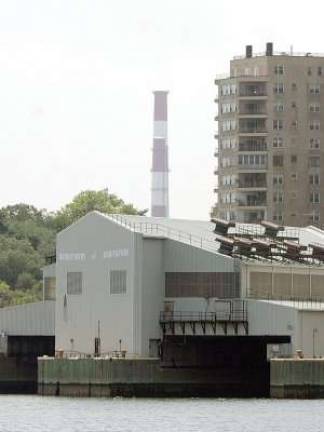A Fishy Business

City announces bid for Asphalt Green garbage plant as Maloney and reps cry foul
Although garbage collection is a dirty job, the old saying goes that someone has to do it. On that note, garbage must also go somewhere. That "somewhere" may soon be the old Marine Transfer Station (MTS) at East 91st Street and York Avenue, though a Hail Mary pass from Rep. Carolyn Maloney and the efforts of some tenacious residents might derail the plan before it gets started.
Last week, the city announced that it was hosting a bid to construct and reopen the MTS, despite the fact that the Army Corp of Engineers is still considering a permit request and mitigation plan by the New York City Department of Sanitation over building the proposed station.
The Army Corp of Engineers has to approve changes to navigable waterways, a process that is notoriously slow. In the application for the project, Maloney claimed the city provided outdated information, including environmental samples that didn't show the presence of fish in the area, only larvae.
"Local fishermen and the State Department of Environmental Conservation both say that the area around the proposed MTS is teeming with fish-including Atlantic striped bass-and is one of the best fishing spots around," Maloney said. She asked the National Marine Fisheries Service (NMFS) to look into reports that the area around the MTS is a striped bass habitat. While the NMFS doesn't take an up or down vote on Army Corp issues, it does advise them.
"Under the Magnuson-Stevens Act, they are required to study the impact of the MTS on the essential fish habitats in the East River in consultation with the National Marine Fisheries Service," Maloney said.
The striped bass is protected under federal law. The East River was traditionally a home to the fish, but decades of pollution caused them to disappear. As the river has been cleaned up over the last 30 years, an increasing amount of marine life has returned to the Upper East Side.
The city has yet to provide the updated information to the Army Corp of Engineers. Until it does, several local representatives think it's too soon for them to be calling for proposals to build the MTS. The city's new proposal calls for a greatly expanded footprint on the structure that is already there, which would expand over the East River.
In response to the city's announcement of the proposal for the MTS, Maloney and several Upper East Side representatives, including State Sen. Liz Krueger and Assembly Member Micah Kellner, came together to spell out why the station would have a negative impact on the community and East River.
"The city needs a permit from the Army Corps of Engineers to build over the East River. They don't have it. And, in our view, they shouldn't get it. It is clear that this project is an environmental disaster and that it will exert a negative impact on essential fish habitats in the East River," Maloney said at the event.
"Our community has been clear in our opposition to the construction of this facility, but now residents of the East Side have reason to be doubly outraged," said Krueger. "In soliciting bids before completing a host of other necessary steps, the city government has attempted to jump the gun and short-circuit its responsibility to safeguard the East River environment and our communities."
Another reason Maloney said the MTS shouldn't be built in the neighborhood is that it is in the middle of what the city has designated as a "Hurricane Evacuation Zone A," which is under the greatest risk of flooding from a storm surge. "In the case of a flood, the MTS would flood not only into the East River but into the community as well," she said. The original station that stands on the location was built in the 1960s and was closed in the early 1990s. When it was built, it was situated next to a factory that produced asphalt and the water in the East River was not as clean as it is today.
Since then, the neighborhood surrounding the proposed site has flourished. Long gone is the factory that gave Asphalt Green Park its name. Located nearby now are two schools, two public housing developments and a senior center that have popped up in the neighborhood.
The city has claimed in the past that the plan to reopen the MTS is part of an effort to redress the disproportionate number of garbage transfer stations in low-income communities.
According to a study done by the Macaulay Honors Society at CUNY on the MTS, these facilities have been located in low-income areas, such as Williamsburg or the South Bronx, to which trucks drive trash from Manhattan. Over half of the existing stations are in Brooklyn, where the median income for households is $40,000. Household incomes near the MTS in the South Bronx are even lower; $21,000 is the average.
The mayor's office and City Council Speaker Christine Quinn's office didn't return calls or messages seeking comment. Peter Sapienza, a lieutenant in the Fire Department and 25-year resident of the community, feels that due to higher than normal air pollution on the Upper East Side, the city should rethink its proposal.
"New York City has the highest rates of asthma due to the No. 6 fuel oil that most buildings' boilers use," he said. The Upper East Side has the highest number of buildings using No. 6 oil in the city and that, on top of the new station, he said will create an even more polluted environment for neighborhood residents.
On an unusually warm winter day, Suzanne Antonelli, a grandmother, sat with her grandkids at Asphalt Green Park. She voiced her concern over how traffic to the waste station would make an already dangerous intersection even worse. "It is just going to congest it so much more," she said. "I just don't know where Bloomberg's head is with this whole thing."